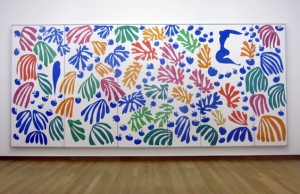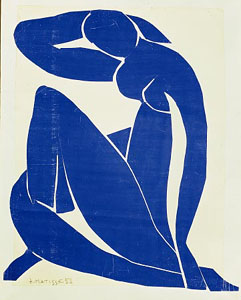Henri Matisse – The Cut Outs: Tate Modern, London, until 7 Sep 2014
This exhibition is a complete joy. Not only are the rooms full to brimming with colourful and uplifting works, but the underlying story of Matisse refusing to be bowed by his abdominal cancer is one of human spirit and imagination. As the rooms at the show open one into another, we see that the works grew in size and vibrancy as the artist’s life ebbed away. As you close the door on the final room, which fittingly contains a stained glass window for the Vence Chapel, you cannot help but reflect on the resourcefulness of this man and his refusal to stop work. It is a remarkable story.
Born in Northern France in 1869, Matisse trained in law, but his interest in art took hold when he started painting whilst recuperating from an illness at the age of 21. He underwent classical training and enjoyed early success with Salon-approved work, but inevitably became swept up by the rich years of artistic change in France in the early twentieth century under the influence of the post-impressionists. The Fauvist style that he worked to at this time arguably never left him, capturing a mood without abandoning realism, working with a saturated palette and dynamic line.
Matisse was a painter and a sculptor, and the combined artistic eye that he thereby developed must have provided the underpinning for his move to the use of cut-outs as his method of creating works. For the last ten years of his life, as his motor skills declined, he continued to work not by applying paint directly to canvas, but by applying coloured shapes in its stead. You get the distinct impression that creating art gave him a reason to live, and that this novel artform filled his waking moments. Under instruction, his assistants would pre-prepare sheets of paper with gouache in selected solid colour, and then hold the sheets while Matisse swept scissors through them to create his shapes. He then supervised the attachment of these shapes to canvasses as he lay in bed, his assistants pinning and then patiently moving them ever-so-slightly until he was fully satisfied with their positioning. Cut-outs had become a medium, bringing a three-dimensions to the plane of a canvass.
The exhibition recalls that Matisse first used cut-outs to help him arrange the objects he painted in still-life and early works, enabling him to shift the placing of a jug or apples until the composition suited his eye. The process developed in Matisse’s designs for a book – Jazz (published 1947) – which was his first major project using the cut-out medium, and we can meander the room that shows these pages comparing the original cutouts to the printed formats. Matisse was irritated by the loss of sensitivity in the printing process, and we hear no more of that: he rather liked the process of assembly and preferred that the attention he paid to it be evident in the work instead of being airbrushed out.
The exhibition then allows us unfettered access to large works, whole walls of cut-outs that he masterminded from a distance, rotating, inverting and moving the pieces until he was satisfied with the combinations. You love them or hate them – they are too loud to ignore and have no opinion of. The interior of his studio in Vence became a canvas for his work and these are on show, the cut-outs are today glued in place but in their original placings the leaf-like forms may well have wafted slightly as the breeze blew through. Matisse said the result of these works was the nearest thing to being in a garden when he was confined to bed.
Room 9 contains the Blue Nudes. Oddly numbered, IV was the first to be completed and required extra bits of paper to achieve Matisse’s desired form. The other three followed – from single sheets – within hours as his confidence grew. There is obvious recall of primitive form, perhaps dating back to Matisse’s sojourn in Tahiti some thirty years earlier, but more striking is the mix of sculpture and painting that these cut-outs allow. The limbs entwine, contours of the body are communicated with flat paper. Cleverly curated with some of Matisse’s nude sculptures in the centre of the room these works are truly a testimony to his craft, amazingly produced when he was old (now 78) and frail.
There is a lot to see at this exhibition, and it is mainly jolly and apparently simple stuff that will appeal to young children for its vibrancy and the potential to have a go themselves when they get home. For the rest of us, it is a journey that is at once uplifting and shouts the resilience and creativity possible in old age and ill-health. It is unpretentious and fun.



